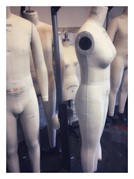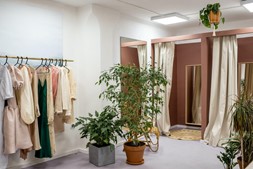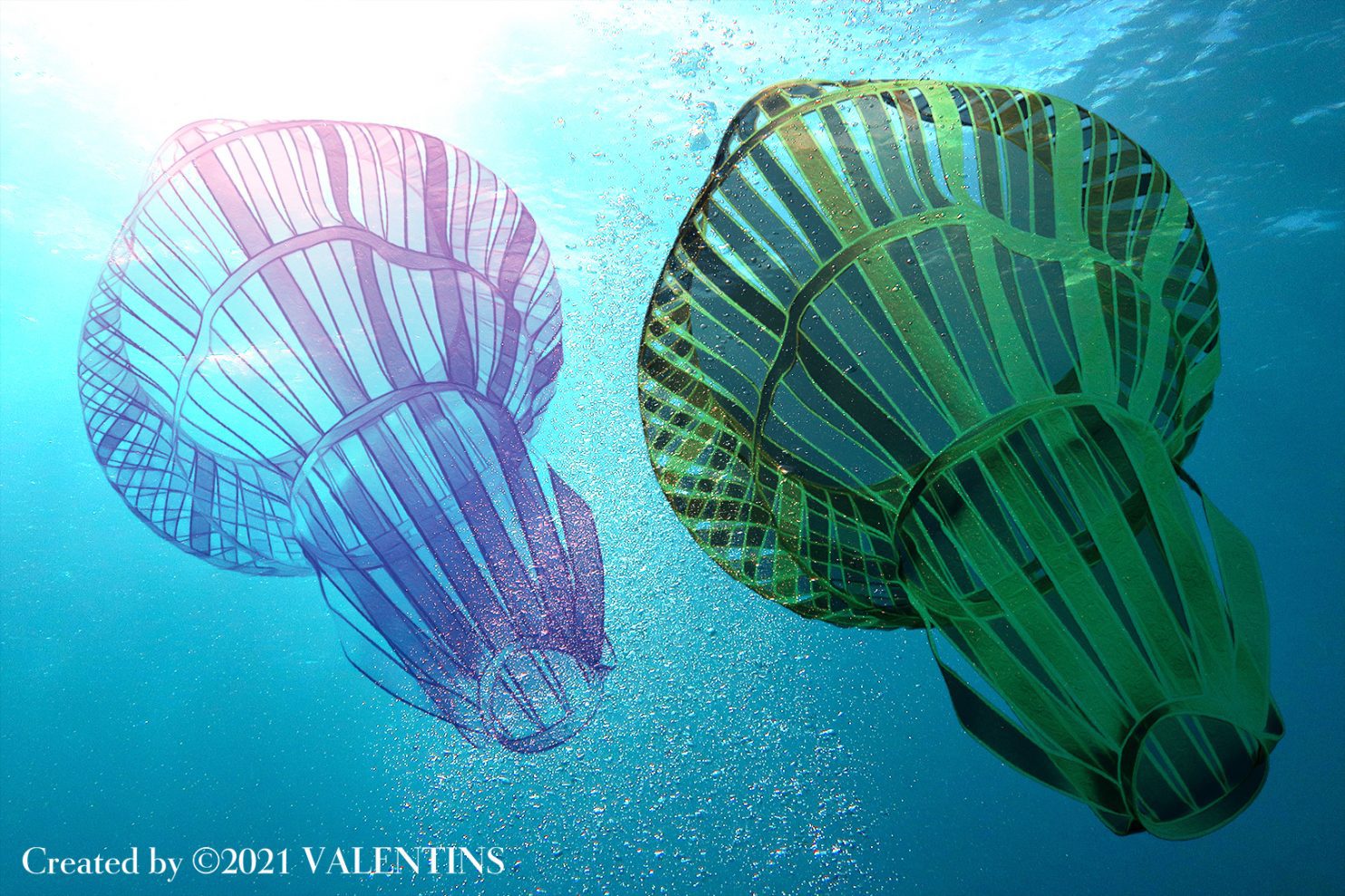Living in a world that is being revolutionized by technology, the fashion industry is playing its part with the innovation and evolution of 3D design. This technology has transformed the way designers think about the garments they are creating, and what the apparel industry will look like in a post-covid world. (Image above from Valentin Karabanov [website, Instagram, LinkedIn]).
The Evolution of Technology in Design

3D design is becoming the leading conversation in the fashion industry. With less than 3% of the industry currently utilizing the technology, the benefits are becoming more widely known and relevant in today’s climate. During the pandemic, 3D design boomed as brands took advantage of virtual fashion shows to keep their clients engaged and showcase their creations. One designer of note created a huge buzz in the fashion world, as she brought her designs to life in the midst of a pandemic. Anifa Mvuemba, designer and founder of Hanifa, created a women’s line to embrace beautiful curves, using bright bold colors and unique textures. Through Instagram Live, Mvuemba showcased her official collection, Pink Label Congo, with 3D models. The haunting effect of her digital art made jaws drop and Anifa Mvuemba became the talk of the fashion world for being the first designer to ever launch a line on social media with a virtual fashion show.
Now more than ever, brands, retailers, and designers are taking advantage of what 3D design has to offer. The countless benefits of this technology range from garments having a more realistic look during the design process, to helping make better decisions on the execution of the aesthetic, adjusting fit instantly, not to mention the large impact on sustainability. With the improvement of accuracy in this environment, fewer samples are needed to realize the final product, saving time, money, and resources. Additionally, due to the ability to more rapidly refine designs without the cost of multiple samples, there is a sense of freedom and expanded creativity that comes with 3D designs. THIS IS THE POWER OF TECHNOLOGY.
Body Scanning for Best Possible Fit
 When it comes to 3D design, designers can make decisions about fit in a virtual landscape. Instead of the traditional process of real life fit models, designers bring science to fit using more predictable, reliable technology. Alvanon, a global fashion innovator has reinvented the way we bring garments to life utilizing body scanning. This technology scans thousands of bodies all over the world, then applies algorithms and programs to determine what the body type for a specific design or pattern should look like. From that data, virtual mannequins are created in a variety of shapes and sizes to allow a look at the detail behind the fit of every single garment. This information provides clarity on how people actually grow in size ensuring the best possible fit for everyone.
When it comes to 3D design, designers can make decisions about fit in a virtual landscape. Instead of the traditional process of real life fit models, designers bring science to fit using more predictable, reliable technology. Alvanon, a global fashion innovator has reinvented the way we bring garments to life utilizing body scanning. This technology scans thousands of bodies all over the world, then applies algorithms and programs to determine what the body type for a specific design or pattern should look like. From that data, virtual mannequins are created in a variety of shapes and sizes to allow a look at the detail behind the fit of every single garment. This information provides clarity on how people actually grow in size ensuring the best possible fit for everyone.
With this technology, manufacturers can collect more body shape and measurement information about consumers, which will hopefully become more mainstream with time. Eventually, this may lead to a standard for fit in every body, shape, and size, making shopping online for clothes a better experience.
Fitting Rooms are Going Virtual
 The COVID-19 pandemic altered the way many consumers shop for garments. Visiting brick-and-mortar stores to try on and purchase clothing during the height of the pandemic was nearly impossible. The consumer’s reaction to the shutdown of retail stores was to turn to the internet. Online shopping, however, presents challenges to both consumers and retailers as shoppers have no way of determining prior to a purchase how garments will fit their unique body. With the cost of returns commonly at 20-30% of sales, developing solutions to improve transparency on fit is vital. An option many companies are exploring is a fitting room experience at home. Fortunately, there are a lot of technologies out there, such as FX mirrors, so consumers can make sure they look fantastic in a garment from the comfort of their own home. Yet, there is an unforeseen surprise in the adoption of this technology. Many consumers do not see themselves virtually the same way they do physically, making it more challenging to connect to a garment and feel good about the purchase.
The COVID-19 pandemic altered the way many consumers shop for garments. Visiting brick-and-mortar stores to try on and purchase clothing during the height of the pandemic was nearly impossible. The consumer’s reaction to the shutdown of retail stores was to turn to the internet. Online shopping, however, presents challenges to both consumers and retailers as shoppers have no way of determining prior to a purchase how garments will fit their unique body. With the cost of returns commonly at 20-30% of sales, developing solutions to improve transparency on fit is vital. An option many companies are exploring is a fitting room experience at home. Fortunately, there are a lot of technologies out there, such as FX mirrors, so consumers can make sure they look fantastic in a garment from the comfort of their own home. Yet, there is an unforeseen surprise in the adoption of this technology. Many consumers do not see themselves virtually the same way they do physically, making it more challenging to connect to a garment and feel good about the purchase.
Whole Garment Knitting and 3D Knitting
 The embrace of 3D technology is becoming more firmly immersed in the knitting sector of the fashion industry. Whole garment knitting, otherwise known as 3D knitting, has become one of the major innovations. Through robotic knitting, one can do things that can’t physically be done with traditional knittings, such as transferring from normal yarn to an antimicrobial yarn invisibly, or shaping the garment to a specific body type.
The embrace of 3D technology is becoming more firmly immersed in the knitting sector of the fashion industry. Whole garment knitting, otherwise known as 3D knitting, has become one of the major innovations. Through robotic knitting, one can do things that can’t physically be done with traditional knittings, such as transferring from normal yarn to an antimicrobial yarn invisibly, or shaping the garment to a specific body type.
There are two large companies in this space, STOLL and Shima Seiki, who are contributing to the whole garment knitting industry. Both are manufacturers that specialize in computerized flat knitting machines. This technology is smart, speedy, sustainable, and has the ability to transfer yarns and complete other tasks that people can’t physically do with their hands.
As 3D knitting machines continue to evolve, the ability for these machines to knit faster, and more efficiently will increase. Right now, machines require a lot of programming, but companies like these are trying to create simpler programs for designers to use, which will be perfect for companies in the United States looking to nearshore their manufacturing.
Technology and the Fix of the Fast Fashion Model
 Trends are changing by the day and while brands and retailers try to keep up with them using the fast fashion model, it brings rise to the concern of sustainability. As fast fashion creates challenges for sustainability, and consumers are increasingly seeking brands that share better values. Emily Lane, CSO at Stars Design Group said, “Fast fashion and the role it plays in creating price points in apparel, and really understanding what’s a realistic price point for something that is sustainable… seems to me like that might be one of the core challenges in the industry right now.”
Trends are changing by the day and while brands and retailers try to keep up with them using the fast fashion model, it brings rise to the concern of sustainability. As fast fashion creates challenges for sustainability, and consumers are increasingly seeking brands that share better values. Emily Lane, CSO at Stars Design Group said, “Fast fashion and the role it plays in creating price points in apparel, and really understanding what’s a realistic price point for something that is sustainable… seems to me like that might be one of the core challenges in the industry right now.”
Low price points and sustainability are difficult to align. Rather than lower price points commonly found in fast fashion, sustainable pieces offer quality, ethical contributions, and are eco-friendly. The combination of technology and infrastructure to support sustainable manufacturing currently not meeting the demand, therefore sustainable apparel is more expensive.
Overcoming Challenges
There are many challenges within the fashion industry, but with challenges comes opportunity. Modern technologies such as 3D design have certainly revolutionized the fashion world, how designers think about the garments they are creating, and what the industry looks like in the post-covid world. If we can help navigate for more information on this topic, visit our website, follow us on social media, and tune in to our podcast Clothing Coulture, found on YouTube and all your favorite podcast streaming platforms.

Saba Desta is an experienced content curator with a demonstrated history of working in the apparel and fashion industry. With a background in Digital Media Production & Digital Journalism, her passion for creating has landed her a full-time position at Stars Design Group as the Marketing Specialist & Content Curator.
About Stars Design Group: Founded by industry experts, Stars Design Group global fashion design and production house that helps clients bring their apparel to market. We consult, design, and facilitate production and delivery.
Understanding that the apparel industry is about evolution and not revolution, we continue to refine the way the industry does business. Embracing the latest 3D design and development software, we help to refine the design and approval process in a digital landscape, paving the way for rapid decisions and execution of programs while reducing mistakes, improving fit, minimizing returns, and increasing profit margins.
With a network of 67 factories in 14 countries worldwide, our relationships are generations deep. Being diverse in our manufacturing locations, we are nimble in an ever-evolving landscape and provide ethically manufactured apparel and accessories.


